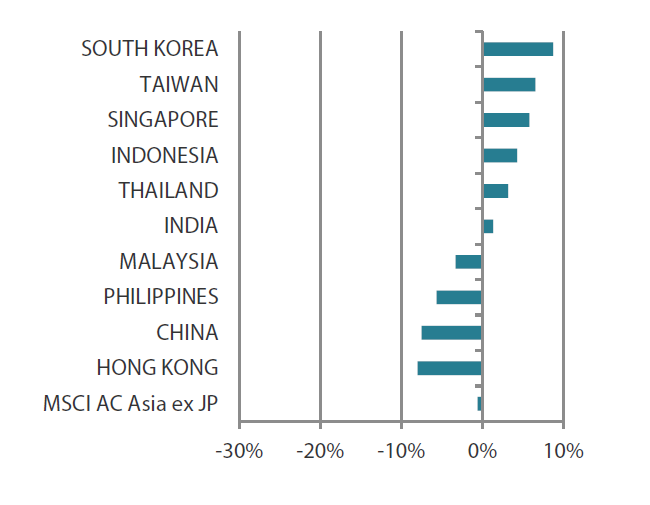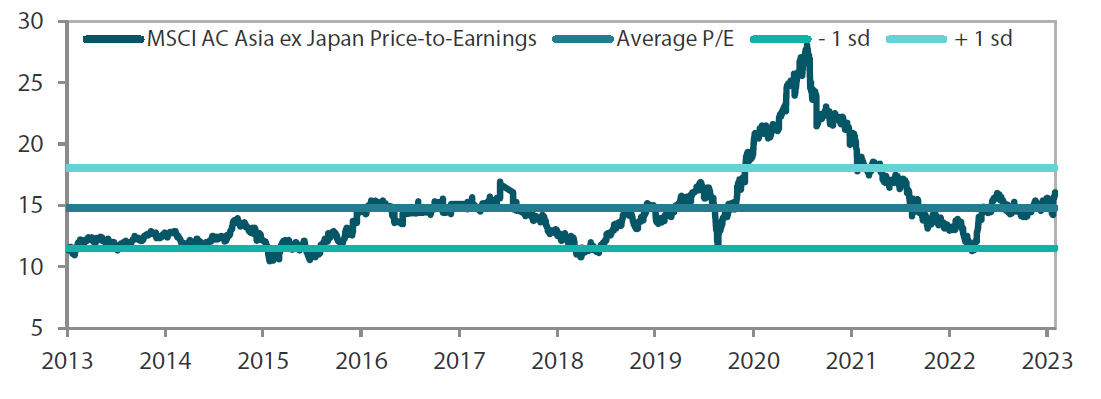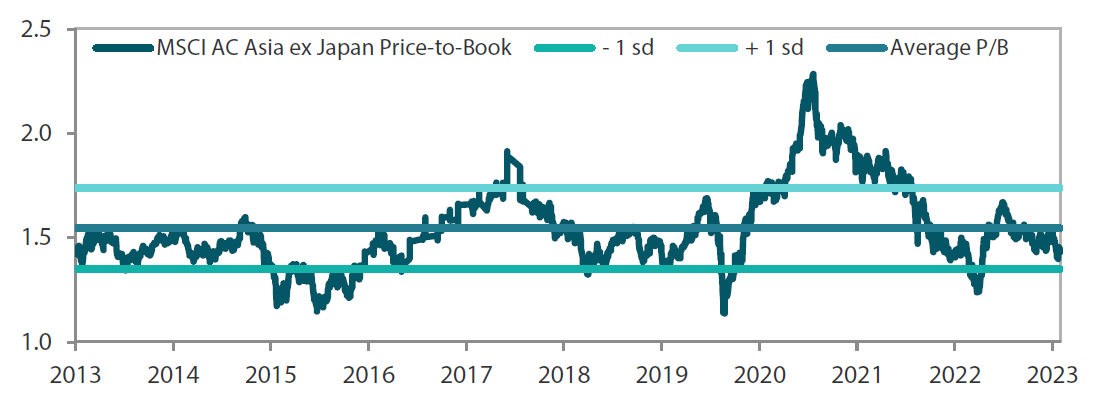Summary
- While regional markets understandably retained its focus on the economic weakness in China, we believe that the fear gripping the markets belies the region’s long-term sustainable return and positive change opportunities. The challenges that China must overcome are not insurmountable and certainly do not translate to systematic or social instability risk, in our view.
- For the month, the MSCI AC Asia ex Japan Index slumped 6.4% in US dollar (USD) terms, pressured by lacklustre macroeconomic data out of China amid renewed stress in the country’s debt-laden property sector. The US Federal Reserve (Fed)’s hawkish tone on inflation and interest rates also dampened risk appetite.
- The Philippines (-9.3%), China (-9.0%) and Hong Kong (-8.6%) led the losses, whereas Indonesia (-1.4%), India (-1.9%) and Thailand (-2.8%) fared relatively better amid the sharp sell-off in the region.
- The market pullback could lead to potential long-term opportunities in China, in our view. India and ASEAN continue to present a compelling structural growth story, whilst North Asian technology companies ride on the wave of artificial intelligence (AI)-driven growth.
Market review
Asian markets slump on China economic weakness and property sector headwinds
Regional equities, as measured by the MSCI AC Asia ex Japan Index, declined 6.4% in USD terms in August, pressured by lacklustre macroeconomic data out of China amid renewed stress in the country’s debt-laden property sector. The Fed’s hawkish tone also dampened risk appetite as Chair Jerome Powell commented that US inflation remains too high and that the central bank is open to additional rate hikes if necessary. During the month, regional currencies weakened against a broadly stronger greenback.
Chart 1: 1-yr market performance of MSCI AC Asia ex Japan vs. Emerging Markets vs. All Country World Index

Source: Bloomberg, 31 August 2023. Returns are in USD. Past performance is not necessarily indicative of future performance.
Chart 2: MSCI AC Asia ex Japan versus Emerging Markets versus All Country World Index price-to-earnings

Source: Bloomberg, 31 August 2023. Returns are in USD. Past performance is not necessarily indicative of future performance.
China and Hong Kong lead the losses in North Asia
Stocks in China (-9.0%) and Hong Kong (-8.6%) slumped in August, marking one of the worst sell-offs in recent months, as nervous investors cut their equity exposure to the world’s second largest economy. Worries over China's flagging economy and its worsening property slump, as well as the lack of vigorous stimulus measures from Beijing, continued to weigh down investment sentiment in the Chinese equity market. During the month, China cut interest rates, halved stock trading stamp duties and eased home purchase and mortgage rules to spur growth and support the weak equity and property markets, but the measures failed to boost investor confidence.
Despite the ongoing craze in AI-related stocks, the technology-centric markets of South Korea (-7.6%) and Taiwan (-4.5%) succumbed to profit taking and fell during the month, weighed down by a correction in index heavyweights Samsung Electronics and Taiwan Semiconductor Manufacturing Company. In August, the Bank of Korea kept its base rate unchanged at 3.5%, maintaining rates for the fifth straight time as inflation in the country continued to ease. Elsewhere, the Taiwanese economy expanded 1.36% year-on-year (YoY) in the second quarter of 2023 (2Q23), rebounding from the 3.31% decline in 1Q23.
All ASEAN markets retreat; the Philippines nosedives over 9%
All equity markets in the ASEAN region fell in August due to sluggish external demand amid a weak global economy. Losses in Indonesia (-1.4%) were relatively lighter as the country’s economic growth accelerated to 5.17% YoY in 2Q23, shored up by robust household consumption and increased government spending. In Thailand (-2.8%), political concerns eased as the Pheu Thai Party’s Srettha Thavisin become Thailand’s prime minister several months after the general election. Driven by the weaker external demand, Malaysia’s (-3.1%) economic growth slowed to 2.9% YoY in 2Q23, while Singapore (-8.5%) saw its July key exports crater 20.2%, with the trade slump extending for the tenth consecutive month. The Philippines (-9.3%) was the region’s worst performer as its economy grew at the slowest pace in nearly 12 years.
Indian equities fare relatively better
For the month, Indian stocks declined 1.9% as retail inflation spiked to a 15-month high at 7.44% in July, driven mainly by food prices. The country’s trade deficit widened to USD 20.7 billion in July as exports stayed weak on slowing global demand, while the import bill rose due to a weaker local currency. India's GDP did grow 7.8% in the April to June period, driven by a robust services sector and government capital expenditure (capex).
Chart 3: MSCI AC Asia ex Japan Index1
| For the month ending 31 August 2023 | For the year ending 31 August 2023 | |

|

|
Source: Bloomberg, 31 August 2023.
1Note: Equity returns refer to MSCI indices quoted in USD. Returns are based on historical prices. Past performance is not necessarily indicative of future performance.
Market outlook
Market correction seen offering bargain-hunting opportunities in China
While regional markets understandably retained their focus on the economic weakness in China, we believe that the fear gripping the markets belies the long-term sustainable return and positive change opportunities in the region. The challenges that China must overcome are not insurmountable and certainly do not translate to systematic or social instability risk, in our view. In addition to the potential long-term opportunities that the market pullback has presented in China, India and ASEAN continue to offer a compelling structural growth story and North Asian technology companies are riding an AI-driven growth wave.
Despite the Chinese authorities signalling a significant shift towards supporting growth and managing down potential risks in the property and local government financing vehicle (LGFV) markets at the end of July, there has been a conspicuous lack of concrete easing policies since, and the market appears to be losing patience. But in our view the fact that a gap exists between what the authorities have been delivering and what the market expects is not surprising in a top-down driven economy like China. There is usually a time lag between when top-down directives are issued and the time actual changes happen on the ground. We liken this to the month-long policy lag during the post-COVID re-opening in the fourth quarter of 2022. While the exact timing and extent of any easing policies are almost impossible to determine, it is worth noting that throughout President Xi Jinping’s reign, policy actions have been extremely consistent with policy guidance, and we expect this time will be no different.
Elsewhere, we see noises emanating from beleaguered investment trusts as merely a symptom of the weak property market and its impact limited mostly to high-net-worth-individuals. Most importantly, the market correction may have provided bargain-hunting opportunities in high-quality companies with long-term sustainable returns and positive fundamental changes. The prominent areas we are focused on include China’s industrialisation 2.0, the push into electric vehicles (EVs), automation, robotics and renewable technologies.
India and ASEAN benefiting from the positive effects of global supply chain shifts
We also believe that it would also be remiss for investors to limit Asia’s narrative to China, when some of the best growth stories globally are in places like India and ASEAN. The positive effects of shifts in the global supply chain are most clearly being felt in India and ASEAN at present. Reforms in India and Indonesia are catalysing this fundamental change most proactively, and peaking local interest rate cycles could provide a cyclical boost. India can also look forward to a significant capex cycle alongside a multi-year housing upcycle. The aforementioned factors continue to drive our favourable view of high-quality banks and companies leveraged to domestic consumption, capex cycle and EV supply chains in India and Indonesia.
South Korea and Taiwan riding the AI-driven growth trend
Technology heavyweights such as South Korea and Taiwan could also continue riding the global AI-driven hardware buildout trend. This structural growth in demand, especially from hyperscalers, is expected to significantly offset some of the weakness we are still observing in personal computer and smartphone end demand. However, within this construct, we continue to be extremely disciplined on valuations metrices to avoid being blind-sided by retail-led thematic fervour.
Chart 4: MSCI AC Asia ex Japan price-to-earnings

Source: Bloomberg, 31 August 2023. Ratios are computed in USD. The horizontal lines represent the average (the middle line) and one standard deviation on either side of this average for the period shown. Past performance is not necessarily indicative of future performance.
Chart 5: MSCI AC Asia ex Japan price-to-book

Source: Bloomberg, 31 August 2023. Ratios are computed in USD. The horizontal lines represent the average (the middle line) and one standard deviation on either side of this average for the period shown. Past performance is not necessarily indicative of future performance.
Reference to individual stocks is for illustration purpose only and does not guarantee their continued inclusion in the strategy’s portfolio, nor constitute a recommendation to buy or sell.



